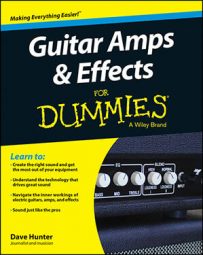What else can you change for less than $5 and so drastically alter the sound and performance of your guitar? Well, your guitar pick, sure, but your strings are a great way to fine-tune your tone, yet they’re so often underappreciated amid all the talk of the big-ticket items. Your strings are literally where the sound originates, so these six humble wires are definitely worth some consideration.
Most guitarists think about their strings, when they think about them at all, more in regard to feel than to sound: Are they the gauge that gives you the desired playing feel under the fingers of your fretting hand? If so, you're likely not to apply much cranial exertion over them until they get a little tired and old, or one breaks, and you need to replace them.
Beyond that, most people find a brand that works for them and stick with that, or semi-randomly grab whatever brand is on the shelf in their price range, and slap ’em on.
Strings of different compositions have slightly different sounds and playing feels, though, so you can tailor both of these crucial factors to your liking by shopping the market wisely.
Investigate these types of strings to find what works best for you:
Nickel-plated: These are the most common types of strings for electric guitar, available from all major brands. The steel wraps of the wound strings on these sets are plated in nickel, which gives an ever-so-slightly round and mellow tone to the otherwise bright, powerful steel cores and steel plain strings.
These strings tend to have a bright, balanced tone when new, though they sound duller as they age. Sometimes you need to do your research to discern nickel wound from pure-nickel wound; the former often just says nickel, but if it doesn’t say pure there’s a good chance they are nickel plated.
Pure-nickel wound: The most common type of string up until the late 1960s when nickel became more expensive, these are still fairly widely available, but they typically cost a little more than nickel-plated strings. The wrap wires on the wound strings in these sets are made from pure nickel, giving a somewhat softer feel and a warm, rich tone.
These strings tend to give the impression of lasting a long time, too, because they don’t suffer the quick decrease of perceived brightness found from some other types.
![[Credit: Photograph by Dave Hunter]](https://www.dummies.com/wp-content/uploads/444388.image0.jpg) Credit: Photograph by Dave Hunter
Credit: Photograph by Dave HunterModern alternatives: Several major makers offer alternatives such as strings made from cobalt, titanium, high-carbon, and/or stainless steel, plus chrome-wraps and other materials. For the most part, these options offer maximum power and brightness. The downside in some cases is a considerable decline in brightness at the end of the life span of some varieties, though many are quite long lasting.
Coated strings: You can also find several varieties of strings that are coated with an extremely fine sleeve of protective material (the term nanotechnology is often bandied here) that helps to repel moisture and finger oils, thereby preserving the life of the string. Some players swear by them, while others have issues with the feel and/or sound.
In addition to these broad varieties, strings can vary widely in outright quality. Because brands and types are changing all the time, the best strings vary for different players, too. However, it is worth paying the little bit extra for American or European-made strings, in most cases, and doing your research to discover which brands tend to be preferred by players of different styles.
Two other broad categories worth your consideration are roundwound and flatwound strings, terms that describe the wraps of the wound strings only.
Flatwounds were the most common strings of the ’50s and early ’60s and remain popular with jazz players in particular. If you’re not a jazzer, or a player of some other style seeking period-correct authenticity in your strings, chances are you will want to play roundwounds anyway.
Roundwounds offer the standard bright, twangy tone most common in rock, blues, country, pop, and so on, whereas flatwounds give you a slightly warmer, mellower tone and a smoother playing feel.

